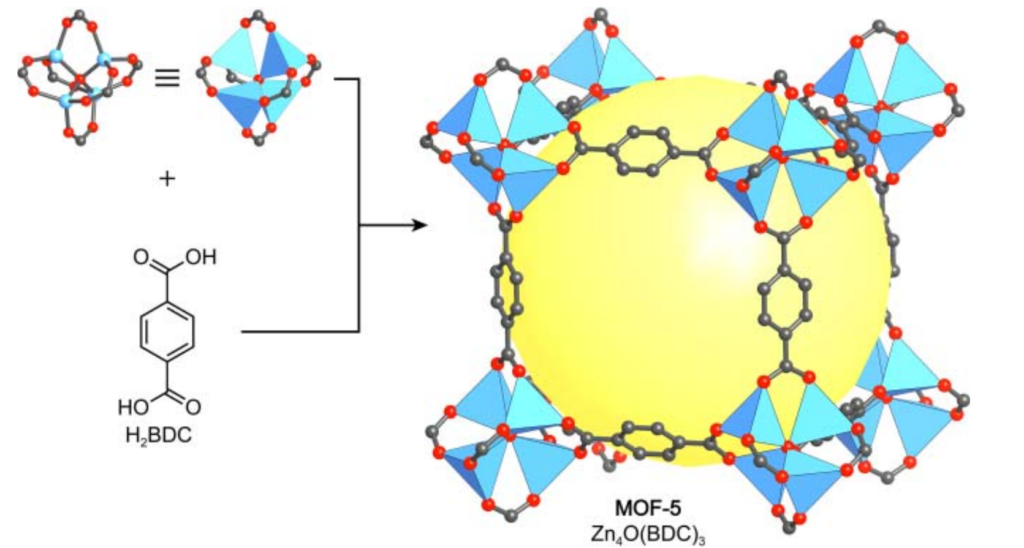Hello curious friends! I’m Chen Junyi, currently a graduate student specializing in Advanced Functional Materials at the University of Glasgow. Today, I want to take you on an exciting journey into the microscopic world of materials science, where tiny particles create big wonders! This adventure began with my post-graduate project, and now I’m thrilled to share it with you.

What are COFs and MOFs?
Imagine building a miniature city, not with bricks and mortar, but with molecules! This is what we explore in research, using Covalent Organic Frameworks (COFs) and Metal-Organic Frameworks (MOFs). These aren’t just ordinary materials, but super materials that can help clean the environment, store gases, or even deliver drugs precisely where they’re needed in the body.
COFs and MOFs are made by connecting molecules into a repeating 3D pattern, kind of like constructing a giant crystal lattice but on a nanoscale. These materials are super porous, meaning they have lots of tiny holes that can capture or release other molecules. This makes them incredibly useful for a wide range of applications!
So, what is the difference between COFs and MOFs? Although both are composed of molecules connected in a repeating 3D pattern, the main differences lie in their composition and the way they are linked:
COFs : These are made entirely of light elements such as carbon, hydrogen, oxygen, etc., and are interconnected through covalent bonds (strong connections like the ones between hydrogen and oxygen in water molecules). This material is very stable and difficult to break down.
MOFs : These contain metal ions and organic ligands (molecules that help arrange the metal ions), linked via coordination bonds (a more flexible type of connection). This allows MOFs to have many different structures and a broader range of uses.
In short, if you think of them as buildings, COFs are like constructions made with one type of sturdy brick, while MOFs are built with a variety of materials, including some metal components, allowing for more complex structures. This makes MOFs more flexible in adjusting and optimizing their performance.

What does SBU mean?
SBU (Secondary Building Unit) refers to the fundamental building blocks in COFs (Covalent Organic Frameworks) and MOFs (Metal-Organic Frameworks), typically consisting of metal ions or clusters coordinated with organic ligands to create porous structures.
How do we make these materials?
Creating COFs and MOFs can be tricky. Traditional methods are like slow cooking; they take a lot of time and energy. But under the guidance of my mentor, Dr. Hessam Mehr, we use something called an aerosol reactor. This reactor is like a magic box that allows us to create these materials faster and with less waste, which is great for the environment!

What does Piezoelectric atomiser means?
Piezoelectric atomisers use the piezoelectric effect to generate ultrasonic vibrations, which rapidly transform a liquid into a fine mist or aerosol. These devices are commonly used in applications ranging from medical nebulizers to fragrance diffusers, leveraging their ability to produce fine, consistent particles without heat.
What’s special about an aerosol reactor?
An aerosol reactor works by spraying tiny droplets or particles through a mist, which then transform into COFs or MOFs. Think of it as using a spray paint can to create a detailed mural. Each droplet has all the ingredients needed to form our materials, and when they meet, they stick together in just the right way.

This method is not only quick but also very efficient. It allows us to experiment with different recipes for making COFs and MOFs, tweaking the process until we get the best possible material for a specific job, like finding the best ingredients for a super cake.
Why does this matter?
You might wonder, why should we care about these tiny materials? Well, they could be game-changers in many fields. For example, they could capture harmful gases from the air or help store renewable energy more efficiently. They might even be used in medical treatments to deliver drugs precisely where they are needed, minimizing side effects.

What does SEM means?
A Scanning Electron Microscope (SEM) is a high-resolution microscope that utilizes an electron beam to scan the surface of a specimen, creating images that reveal the surface topography and composition of materials. SEM is extensively used in fields such as materials science, biology, and industrial inspection, providing detailed insights at the nano to micro scale.
The future is bright!
Research in this field is like being both a magician and a scientist. Every day, we discover more about what these tiny structures can do and how they can help us solve some of the world’s big problems.
I hope this brief introduction to the world of COFs and MOFs has sparked your curiosity. Perhaps one day, you’ll join us in the lab to discover even more materials that can make the world a better place. Until then, keep wondering, asking questions, and exploring the world around you.

Leave a Reply
You must be logged in to post a comment.